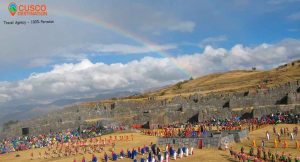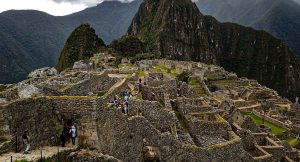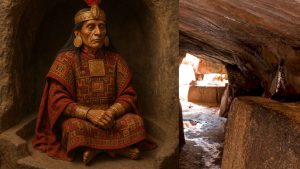The Sacred Valley of the Incas is one of Peru’s most fascinating regions, both for its historical richness and natural beauty. Located in the Peruvian Andes, this valley was a key center for the Inca civilization due to its favorable geographic and climatic conditions.

Location and Geography
The Sacred Valley stretches between the towns of Pisac and Ollantaytambo, following the course of the Vilcanota River. Its altitude varies between 2,000 and 2,800 meters above sea level, giving it a temperate climate with temperatures ranging from 22 to 25°C during the day and 8 to 10°C at night.
History and Cultural Significance
The Incas greatly valued this valley for its fertility and made it an important agricultural center, especially for the cultivation of corn. Furthermore, the Sacred Valley is home to numerous archaeological sites, such as Pisac, Ollantaytambo, Moray, and the Maras Salt Mines, which showcase the Inca’s advanced engineering and urban planning.
Main Attractions
– Pisac: Famous for its artisan market and archaeological complex with agricultural terraces and astronomical observatories.
– Ollantaytambo: Known as the “living Inca village,” it features an impressive fortress and streets that preserve the original Inca layout.
– Moray: An archaeological site with circular terraces believed to have been used for agricultural experiments.
– Maras Salt Mines: Thousands of salt pools that have been exploited since pre-Inca times.
Tourism and Activities
The Sacred Valley is ideal for experiential tourism, where visitors can learn about the local culture and participate in activities such as traditional weaving in Chinchero. It is also a perfect destination for hiking, mountain biking, and rafting on the Vilcanota River.

The Sacred Valley of the Incas is an ideal destination for adventure lovers, offering a wide variety of activities that combine adrenaline and spectacular scenery. Here are some exciting options:
1. Rafting on the Urubamba River
The Urubamba River offers stretches of water with varying levels of difficulty, ideal for beginners and experts. During the rainy season, the river’s flow increases, making the experience even more challenging.
2. Zip Line
In the Pachar sector, between Urubamba and Ollantaytambo, you can glide along cables suspended over the valley, enjoying breathtaking views while experiencing the speed and excitement.
3. Paragliding in Chinchero
If you’re looking for a unique experience, paragliding allows you to fly over the Sacred Valley and admire its landscapes from above. It is carried out with trained instructors to ensure safety.
4. Hiking and Trekking
The Sacred Valley has numerous hiking trails, from short walks to longer expeditions. Some options include:
– Chinchero to Poc-Poc Waterfalls Route
– Three-day Cachicata Hike to Ollantaytambo
– Excursion to the Maras Salt Mines and Moray Terraces
5. Mountain Biking
Biking routes in the Sacred Valley pass through spectacular landscapes and archaeological sites. You can explore trails connecting Pisac, Urubamba, and Ollantaytambo, enjoying nature and history.
6. Rock Climbing and Via Ferrata
In Pachar, you can rock climb and explore via ferrata circuits, which include vertical ascents and zip lines. This is a perfect activity for those seeking a physical challenge.
7. Horseback Riding
Exploring the Sacred Valley on horseback is a peaceful and unique way to experience its landscapes. You can explore trails to Maras, Moray, and Chacan, enjoying nature and the local culture.
Climate and Best Time to Visit
The best time to visit the Sacred Valley is during the dry season, from April to October, when rainfall is less frequent and the weather is more stable.

The Sacred Valley of the Incas was a fundamental region for the Inca civilization due to its agricultural wealth, its spiritual significance, and its strategic importance within the Tahuantinsuyu. Here I explain its main aspects:
1. Fertility and Agricultural Production
The Sacred Valley had a temperate climate and fertile soils, making it the main center for the production of corn, an essential food for the Incas. Potatoes, quinoa, and other crops were also grown, ensuring food supplies for the population and the ruling elite.
2. Spiritual Significance
For the Inca, the Vilcanota-Urubamba River was sacred and represented the Milky Way in the Andean worldview. Many of the structures in the valley, such as Pisac, Ollantaytambo, and Moray, were aligned with astronomical events and served ceremonial purposes. 3. Administrative and Military Centers
The Sacred Valley was home to important fortresses and administrative centers, such as Ollantaytambo, which served as a defense point against invasions. It was also a strategic corridor connecting Cusco with the Amazon rainforest.
4. Expansion of the Empire
Under Pachacuti’s rule, the Sacred Valley became a key hub for the expansion of the Inca empire. Palaces and temples were built that reflected the power and organization of the civilization.
5. Cultural Legacy
Today, the Sacred Valley remains a major agricultural and tourist center. Local communities preserve ancestral farming techniques, rituals, and festivals that keep the Inca legacy alive.







Leave A Reply